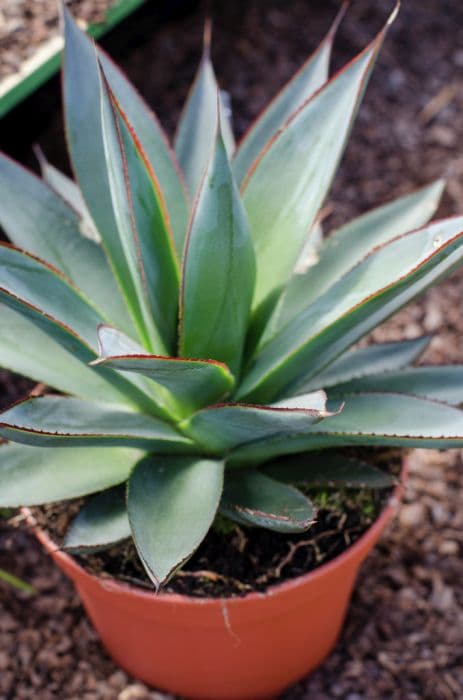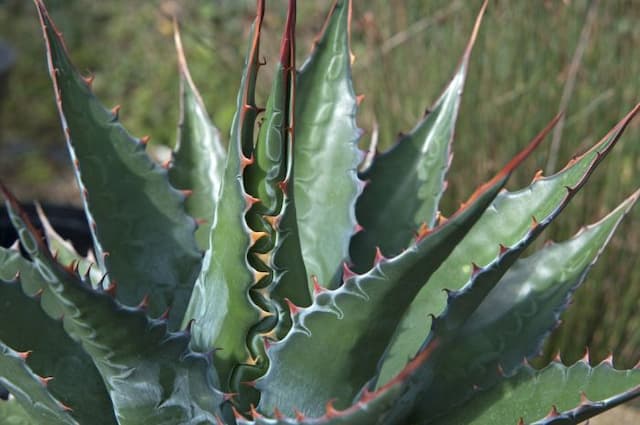Variegated Century Plant Agave americana 'Variegata' (v)

ABOUT
The Agave americana 'Variegata', more commonly known as the variegated century plant, is a striking succulent with distinctive ornamental appeal. Its appearance is marked by bold rosettes of thick, fleshy leaves that are both robust and sculptural in form. Each leaf exhibits a glaucous green hue with creamy white to yellow marginal stripes running along the edges, creating an intriguing contrast that enhances its visual impact. The leaves of the variegated century plant have a strong architectural quality, with their pointed tips and sharp spines found at both the apex and along the margins, providing a formidable presence. The variegation on the leaves may vary, resulting in unique patterns that add to the individuality and charm of each plant. This variegation not only adds to the beauty of the Agave americana 'Variegata' but also helps to reflect sunlight, which can be particularly valuable in the bright, sun-drenched environments that this plant favors. When mature, the variegated century plant is capable of producing a towering flower stalk, which can make it a true spectacle when in bloom. The bloom is a rare event in the lifespan of any single rosette, often occurring once before the rosette dies, but the flourish of flowers is noteworthy, attracting pollinators and admirers alike. To summarize, the variegated century plant is a visually stunning specimen with rosettes of green leaves edged in creamy white or yellow stripes, sharp spines, and a grand floral display that punctuates its life cycle. It is a popular choice for gardens and landscaping where its showy foliage can be prominently displayed.
About this plant
 Names
NamesFamily
Asparagaceae
Synonyms
Variegated Century Plant, Variegated American Agave, Variegated Maguey, Striped Agave, Variegated Agave
Common names
Agave americana var. marginata Trel., Agave americana var. medio-picta alba, Agave americana var. medio-picta aurea, Agave americana var. picta Salm-Dyck, Agave americana var. striata Trel., Agave expansa Jacobi, Agave picta (Salm-Dyck) G.D.Rowley, Agave rasconensis Trel., Agave variegata Jacobi, Agave virginica Mill., Aloe americana (L.) Crantz, Aloe picta Salm-Dyck.
 Toxicity
ToxicityTo humans
The Century Plant contains saponins and oxalate crystals that can be toxic if ingested. Consumption of leaves or sap can lead to a burning sensation in the mouth and throat, swelling, and difficulty breathing. Further, if sap contacts the skin, it can cause dermatitis or an allergic reaction. Ingesting large quantities may cause nausea, vomiting, diarrhea, and a rare possibility of more severe reactions depending on the quantity ingested and individual sensitivity.
To pets
The Century Plant is also toxic to pets, including dogs and cats, due to its saponins and oxalate crystals. If pets chew or ingest any part of the plant, they can experience symptoms such as vomiting, diarrhea, drooling, and a lack of appetite. Contact with the sap may also result in skin irritation or an allergic reaction. Serious cases might lead to more severe symptoms such as trembling or difficulty breathing, and it may necessitate a visit to the veterinarian.
 Characteristics
CharacteristicsLife cycle
Perennials
Foliage type
Evergreen
Color of leaves
Variegated
Flower color
Yellow
Height
6 feet [1.8 meters]
Spread
8 feet [2.4 meters]
Plant type
Succulent
Hardiness zones
8
Native area
Mexico
Benefits
 General Benefits
General Benefits- Drought Tolerance: Thrives in dry conditions with minimal watering once established, reducing water use.
- Low Maintenance: Requires little care, making it ideal for gardeners with limited time.
- Architectural Interest: Adds a bold, structural element to gardens with its rosettes of striped, spiky leaves.
- Long Lifespan: Lives for many years, often flowering only once before dying, but leaving behind offsets.
- Erosion Control: Its extensive root system can help stabilize soil and prevent erosion on slopes.
- Wildlife Attraction: Flowers may attract pollinators such as bees and hummingbirds.
- Variegation: Offers visual interest with its variegated foliage, adding contrast and color to the garden.
- Heat Tolerance: Well-suited to hot climates and full sun exposure, making it a good choice for xeriscaping.
- Deer Resistance: Generally not palatable to deer, reducing the likelihood of damage from wildlife.
- Cultural Significance: Has a history of use in traditional crafts and customs, providing a connection to heritage and history.
 Medical Properties
Medical Properties- Antiseptic: The sap of Agave americana 'Variegata' was traditionally used for its antiseptic properties.
- Anti-inflammatory: The plant's components may possess anti-inflammatory effects.
- Wound Healing: The sap has been used in traditional medicine to promote the healing of minor wounds.
 Air-purifying Qualities
Air-purifying QualitiesThis plant is not specifically known for air purifying qualities.
 Other Uses
Other Uses- The fibers of Agave americana 'Variegata' can be used to make ropes or twine, thanks to their strength and durability.
- The sharp, pointed tips of the leaves can be used as natural needles or nails for traditional crafts or for tagging small items in agriculture.
- The agave's sap can be used as an ingredient in natural adhesives or varnishes due to its sticky consistency upon drying.
- The juice extracted from agave leaves can be fermented to produce a traditional Mexican alcoholic beverage called 'pulque', which predates tequila.
- The plant can be incorporated into landscape design as a natural barrier due to its size and spiky leaves, which deter animals and unauthorized persons.
- The sap of this agave, when fresh, is sometimes used as a soap substitute for washing clothes and even for personal hygiene in some cultures.
- When dried, the flower stalks of Agave americana 'Variegata' can be used as building materials or to create fences and other structural elements.
- Shredded leaves of the plant may serve as stuffing for biodegradable garden furniture and mattresses in eco-friendly manufacturing processes.
- The leaves can be cut and used as a natural mulch in gardening to conserve soil moisture and deter weeds.
- Agave americana 'Variegata' leaves are sometimes used in cooking as a wrap for baking meat or fish, imparting a unique flavor to the dish.
Interesting Facts
 Feng Shui
Feng ShuiThe Century Plant is not used in Feng Shui practice.
 Plant Symbolism
Plant Symbolism- Resilience: The Century Plant is known for its ability to thrive in harsh, arid environments, symbolizing the ability to endure and persist through tough conditions.
- Longevity: Its common name suggests a lifespan of a century, thus it symbolizes long life, although it typically lives between 10 to 30 years.
- Protection: With its strong, pointed leaves, the Century Plant represents safeguarding and defense against threats.
- Renewal: This plant blooms only once in its lifetime and then dies, representing the cycle of rebirth and new beginnings.
- Self-reliance: Its ability to store water in its leaves to survive droughts symbolizes self-sufficiency and independence.
 Water
WaterThe Century Plant, or Agave americana 'Variegata', should be watered sparingly, as it is extremely drought tolerant. Allow the soil to dry out completely between waterings, which typically means watering every two to three weeks during the active growth season and less frequently during winter. When you do water, do so thoroughly, providing enough water to soak the roots—approximately 1 to 2 gallons for a plant in a standard outdoor garden setting. Overwatering can lead to root rot, so ensure good drainage and never let the plant sit in water.
 Light
LightCentury Plant thrives best in full sun where it can receive direct sunlight for at least six hours each day. It is ideal to place it in a location where it is exposed to the bright, unfiltered light for the majority of the day. However, it can also tolerate partial shade, especially in extremely hot climates where the afternoon sun can be particularly intense.
 Temperature
TemperatureCentury Plant is best suited to warm climates and can tolerate a wide range of temperatures, thriving in conditions anywhere from 50°F to 90°F. It can withstand temperatures as low as 30°F but should be protected from frost. Ideal growing temperatures are between 70°F and 80°F during the day.
 Pruning
PruningPruning of the Century Plant is generally done to remove dead or damaged leaves and to maintain its appearance. It's best to prune in the spring or early summer. Use sharp, clean tools to avoid any disease transmission and make clean cuts close to the base of the leaf. The Century Plant does not require frequent pruning; doing this as needed is usually sufficient.
 Cleaning
CleaningAs needed
 Soil
SoilCentury Plant thrives in a well-draining soil mix, typically a cactus or succulent blend, to which perlite or sand has been added to improve drainage. The ideal soil pH for Agave americana 'Variegata' should be slightly acidic to slightly alkaline, ranging from 6.0 to 8.0.
 Repotting
RepottingThe Century Plant should be repotted infrequently, as it is a slow grower. Generally, repotting every 3 to 4 years is sufficient, or when the plant has outgrown its current pot.
 Humidity & Misting
Humidity & MistingThe Century Plant prefers dry air and does not require high humidity levels. It is well-suited to the low humidity conditions typically found indoors.
 Suitable locations
Suitable locationsIndoor
Place in bright light, avoid overwatering.
Outdoor
Full sun, well-drained soil, protect from frost.
Hardiness zone
8-11 USDA
 Life cycle
Life cycleThe Agave americana 'Variegata', commonly known as the Variegated Century Plant, starts its life cycle when a seed germinates in well-draining soil, typically in a warm climate. After sprouting, the young agave, also known as a pup, spends several years developing a rosette of thick, fleshy leaves with variegated, cream-colored edges. Throughout its growth, the plant stores energy in its leaves and large root system, maturing slowly over a period that can range from 10 to 30 years. Upon reaching maturity, the agave produces a single, spectacular flowering stalk that can grow up to 15 feet or more, bearing clusters of yellow flowers; this bloom event is the climax of its life. Following flowering, which may last several weeks, the agave directs all its resources into the production of seeds and usually small vegetative offsets around its base. After seeding, the main plant typically dies, while the offsets can be replanted to start new plants, thus continuing the cycle.
 Propogation
PropogationPropogation time
Spring-Summer
The most popular method of propagating the Variegated Century Plant, Agave americana 'Variegata', is through the use of offsets, also known as "pups". These are small clones of the mother plant that grow from its base, which can be removed once they're a few inches in size, typically in the spring or early summer when the plant is actively growing. Wearing gloves to protect from sharp edges and using a clean, sharp knife, carefully cut the pup away from the main plant, ensuring it has some roots attached. Allow the cut surface on the pup and the mother plant to callous over for a few days to prevent rotting. Plant the pup in a well-draining soil mix, water sparingly, and provide bright, indirect light until new growth indicates that the plant has established roots.









